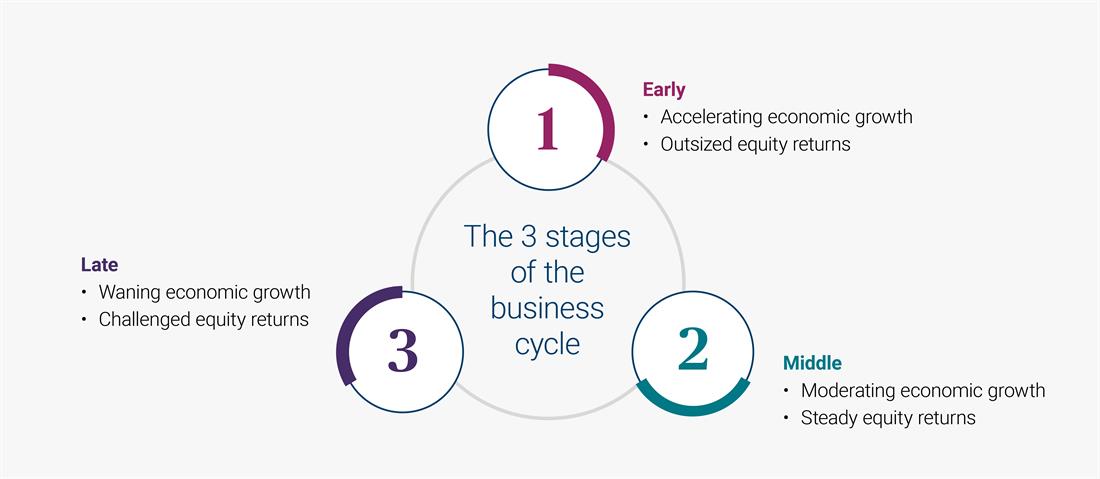Brian Levitt, Global Market Strategist – Invesco
10/20/2025

Investors are conditioned to fear recessions, and for good reason. Over the past 25 years, three recessions have coincided with significant market drawdowns.1
That kind of recency bias can lead investors to brace for the worst, especially following a strong market advance. Could a downturn be imminent? Here’s our recession outlook:
Where are we in the business cycle?
Rather than reacting to fear, it is more productive to assess the health of the business cycle, which is the natural progression and regression of economic growth over time.

As a reminder, business cycles typically unfold in three stages2:
- Early: This phase is marked by accelerating economic growth and outsized equity market returns.
- Middle: This phase is marked by a moderating pace of economic expansion, as well as steady and selective equity returns.
- Late: This stage is marked by waning momentum that may ultimately transition to recession. During the end of the business cycle, equity market returns become increasingly challenged as the cycle matures and transitions toward recession.
What are the indicators of a recession?
Business cycles tend to end with familiar conditions. Here are a few common signs:
- Excess and leverage build up in the economy: For example, in 2008, banks had made too many bad loans, households had borrowed too much and builders had overbuilt.
- Rising interest rates: Central banks typically respond to overheating by raising interest rates to bring inflation back into their comfort zone. The recession of the early 1980s is a textbook example of that.
- Decelerating growth: Growth tends to slow, banks typically tighten lending standards and corporate borrowing costs rise as investors demand higher yields to lend money to businesses.
Assessing today’s economic conditions
We are not in the beginning of the economic cycle, which we believe started when businesses began to reopen after the pandemic. Further, if we reflect on the above recession indicators, today’s conditions do not resemble those of past economic downturns. Rather, we are likely in the middle phase of the business cycle.
Here are a few points to consider:
- Banks are well capitalized.3 This is a result of post-financial crisis regulation. Business borrowing growth has been subdued compared to pre-recession periods.4
- Consumers, in aggregate, have remained relatively healthy. While credit card delinquencies are rising, most of that stress is concentrated in the lowest-income quintile.5 Household net worth is at an all-time high6 and debt service costs relative to income are near historic lows.7
- The housing market isn’t overbuilt.8 In fact, the U.S. has too few homes. Businesses are not burdened with excess inventory.9
- The Federal Reserve is not looking to raise rates. Instead, the central bank is signaling a willingness to lower them, and it can do so because inflation expectations remain contained.10 The risk to the business cycle would be larger if inflation expectations were rising and the Fed was contemplating a hike.
- Growth has been slowing but not collapsing.11 Some leading indicators are showing signs of reacceleration.12 Bank surveys suggest that lending standards tightened when the presidential administration announced sweeping tariffs in April, but they have since stabilized.13
- Corporate borrowing costs have remained low.14 Some view this as a warning sign, suggesting credit is overvalued, but that is often the case in the middle part of the cycle. For corporate borrowing costs to rise meaningfully, there would need to be a catalyst such as tighter policy or weakening growth. Neither appears imminent.
Bottom line: Is a recession imminent?
The business cycle is aging, but economic conditions do not yet point to its conclusion. Rather, it’s our view that the current economic cycle has reached its midpoint, characterized by moderating economic growth and healthy equity returns. As such, investors may want to consider maintaining exposure to risk assets, such as equities and credit.
Get help through different economic cycles
When you work with an Ameriprise financial advisor, they can help identify opportunities to strengthen your financial position throughout different economic cycles. If you have questions about how the broader economic environment may affect your investment portfolio or financial strategy, reach out to your advisor.